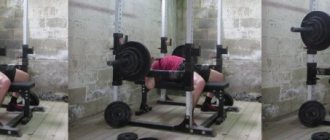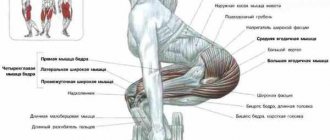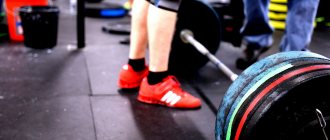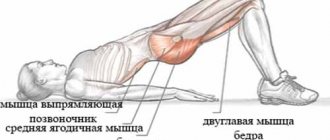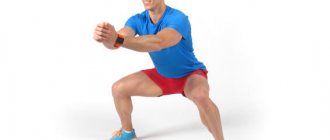Muscles that work
When performing a lying leg press, the load is distributed as follows:
- the main load falls on the quadriceps femoris and gluteus maximus muscles;
- the hamstrings play a supporting role;
- the abs and lower back fix the body;
- The calf muscles are loaded indirectly.
Thus, the bench press in a machine is aimed at working the quadriceps and buttocks, however, various forms of performing the exercise make it possible to redistribute the load (I will show you below detailed diagrams of how we can shift the load depending on the position of the legs on the platform).
Machine Leg Press: An Underrated Exercise.
The bench leg press has a bad reputation among hardcore strength enthusiasts because it is easier to perform than the squat.
You don't need the same degree of joint mobility and athleticism to do it. You simply load the machine with plates and off you go... But just because the leg press in the machine is not as complex an exercise as squats, does not mean that it is bad. In fact, for developing maximum leg size, the machine press is a very worthy movement, because... Allows you to safely pump at a stimulating level of intensity.
Here are my 6 leg press variations to develop freakish leg size and strength:
Leg press in the simulator “increasingly”.
This method is pure “shock and horror” for the entire lower body. The good news about this is that you only need to do one set. The bad news: This will probably be the longest and most painful approach of your life.
You are supposed to perform one long set with micro-stops after every four reps. During each stop, your partner will add a 20kg weight plate to the machine. If you don’t yet have enough strength for such a sharp increase, you can try a 10 kg pancake.
It is necessary to fully extend your legs only during these pauses, which last just long enough to have time to throw on the pancake. In the remaining repetitions, the legs are fully straightened only for a moment, maintaining constant tension in the muscles.
Do as many microsets of 4 reps as possible. It is optimal to set the weight so that the total is 16 repetitions. The starting weight should be approximately 60% of the weight you can bench press 10 times.
Leg press in a machine using harnesses.
With this type of bench leg press, lowering the platform becomes much more difficult because... the cords will try to pull it towards you. The trick here is to stay focused and fight through the resistance.
Start by attaching one band to each side of the leg press machine. Perform sets of 8 repetitions and keep your legs straight, work your legs up and down like pistons, without stopping. Control the weight as you lower, then push the platform out ¾ of the way until your legs are straight, and then lower it again.
Don't use harnesses every leg workout. If used too often, they can kill your joints.
Bench leg press: drop sets.
Drop sets are one of the oldest methods for increasing intensity. Performing them in the case of the leg press on the machine is also extremely difficult, which is why I prefer to do only one such approach (which turns me inside out).
The plates on the leg press machine should be hung in 4 sets for subsequent weight loss. You do 8 reps, drop the weight significantly, and do 8 more reps. After this, repeat the process, throwing off the pancakes 2 more times and doing a total of 32 repetitions.
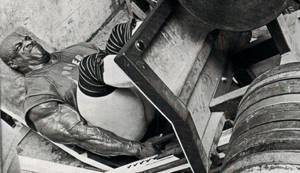
Lowering the weight in 3 seconds.
The key to growing legs is maximizing the muscle's time under tension (TTU). Lowering the leg press platform in 3 seconds serves this purpose.
Start by doing a couple of low rep sets to get up to your working weight, at which you will perform a set of 8 reps with the platform lowered in 3 seconds.
Try to push the platform from the bottom point of the amplitude as powerfully and quickly as possible. There is no need to fix the straightening of the legs, a short pause at the top and immediately down.
Tip: Use a foot position that allows you to push the platform with maximum force. Your goal is to lower the platform deep down in 3 seconds and push it out with the maximum weight possible for you for 8 repetitions.
VMO supersets in the bench press on the quadriceps teardrop-shaped fascicle machine.
The “teardrop” is the part of the quadriceps that everyone dreams of developing, located just above the kneecap.
To target this part of the muscle with the bench press, place your feet close together on the machine platform, slightly lower than their normal position. This method should only be used when the quadriceps are already well engorged, so take care to do plenty of previous sets on them.
The goal here is to create significant metabolic stress, so all sets should be performed with the legs moving like pistons and high repetitions. First, do a couple of sets of 25 repetitions to then reach your working weight.
Get into a rhythm by rocking the platform up and down. Do not fix your straightened legs. After doing 25 repetitions, throw 10 or 20 kg plates on each side. Continue until you can complete the target 25 reps per set. To make the method more effective, combine the bench press with a partial leg extension on the machine.
Leg extensions also get a bad rap among athletes, and while they are not a great exercise for bulking, they are very effective when superset with a machine leg press.
Prepare your knees with several warm-up sets, and then do extensions in the following pattern: 20, 15, 10 and 8 reps, adding weight with each set. Extend your legs only in the lower half of the amplitude, tilting your body back.
Supersets for the outer quadriceps.
This version of the bench leg press focuses more on developing the outer quadriceps (vactus lateralis). Place your feet on the platform of the leg press machine in a wide position, with your toes pointed out to the sides. Allow your knees to extend beyond the contour of your torso as you lower.
The platform must be lifted in an explosive manner. You can allow yourself stops (1 second) and perform repetitions in the “rest-pause” style.
Increase the weight until you can't handle 20 reps, no matter how hard you try. If you've done it 15 times and you need to rest for a second to get to 20, that's fine. My final set will sometimes include 4-5 of these stops until I hit 20 reps.
Do 20 repetitions on all sets. Combine a bench press in this manner with machine leg extensions performed in the upper half of the amplitude. Squeeze your muscles powerfully at the top, and then lower the weight to only half the normal range of motion for this exercise.
Compared to the leg extension option at the lower end of the range, you will have to reduce the weight significantly here. Your quadriceps should be on fire!
Do the bench leg press and strive to increase your results.
Don't avoid an exercise simply because another movement is more effective for that muscle group, because when it comes to hypertrophy training, there are very few options.
A good mass program contains a variety of quality movements that are rotated depending on your needs. Remember that your ultimate success depends more on your efforts than on your choice of exercises.
- Original source
- Translation:
Liked? Share with your friends!
Bench leg press on a machine
It is generally accepted that the best leg exercise is the barbell squat.
This statement is 100 percent true, but subject to certain conditions:
- An athlete must have perfect technique.
- Have healthy lower back and knee joints.
- Be over 18 years of age.
If any of these conditions are not met, weighted squats can cause serious harm to the athlete. I know about this myself, because... I had a torn anterior cruciate ligament in my right knee, so although I squat, I do it very carefully.
I will have a separate article on the blog about recovery from such a knee injury, but for now let’s return to the topic of the article.
The bench press virtually eliminates the above risks. Some bodybuilders say that in terms of the degree of muscle groups involved, the exercise is inferior to squats, and this is true, but this deficiency is easily compensated for by other exercises, and in terms of injury safety and emphasis on working with the bench press in a machine, there is little that can compare.
The exercise is basic - the knee and hip joints take part in the work, and many muscles are involved.
Performing a leg press virtually eliminates the risk of injury to the knees or lower back and does not create stress on the spine, provided the correct technique is followed.
Lift the bar along a curve
In the bench press, the barbell should be lifted not in a straight line, but in an arc resembling the letter J. The force from the legs should correspond to this trajectory. Remember that you are generating force that moves the bar slightly back, not straight up, to create the perfect trajectory. Don't be afraid to push yourself off the bench. The upper back is securely fixed and pressed into the bench so deeply that you definitely won’t move anywhere.

The strong impulse from your legs unifies your body and helps you initiate the barbell movement from the chest from the bottom position. This is a huge benefit because the bench press has an upward force curve: the muscle force required to move the weight decreases as you move through the range, making it easier to lift before full extension. Connecting your legs will help move the barbell the first ten centimeters, and when the projectile passes this point, the strongest extensor muscles will begin to lift it. The J curve movement allows your chest, shoulders and triceps to work synergistically so you can lift maximum weight.
Bench Leg Press: Foot Positioning
I’ll start, perhaps, with the positioning of the legs when doing the bench press, because... this changes the direction of the load and shifts the emphasis to different muscles:
- If our legs are in their original position - feet in the center shoulder-width apart, toes pointing forward - the load falls evenly on the quadriceps and buttocks.
- Shifting the legs to the top of the platform increases the load on the buttocks, turning the toes emphasizes the work of the inner thigh. This is the position I recommend for bench leg presses for girls, because it is important for girls to focus on the buttocks and thighs.
- Shifting the position of the legs below the conditional center line of the platform to work out the outer (narrow legs) and inner (wide legs) heads of the quadriceps should be done with caution, as this creates a strong load on the knees and ankles.
Some bodybuilders practice the platform press with one leg, but this increases the risk of injury of the exercise; this option, by the way, is suitable for knee injuries or other injuries when one limb cannot be trained.
Once again briefly.
How to place your feet:
- Feet high + narrow (or shoulder-width apart): the more your buttocks are involved in the work.
- Feet high + stand wide: the buttocks work and the hip adductors (adductors) are included in the work.
- Feet in the center of the platform, shoulder-width apart: quadriceps + glutes work.
- Feet low on the platform, shoulder-width apart: work the quadriceps in a concentrated manner.
- The wider the feet are at the bottom of the platform, the stronger the INNER (medial) head of the quadriceps works.
- The narrower the feet are at the bottom of the platform, the stronger the EXTERNAL (lateral) head of the quadriceps works.
This clearly looks like the picture below:
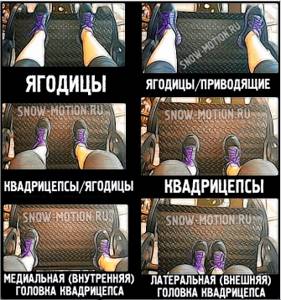
I advise you to read my cool and detailed article about sports injuries.
Knee work: ALWAYS keep your knees bent. When squeezing the platform, do not extend them completely at the top point, because... you will unload your muscles and put a lot of stress on your knee joint. Keep your legs CONSTANTLY bent throughout the entire approach.
How to place your heels: pressed tightly to the platform ALWAYS! Push the platform with your heels (this concentrates the load on the quadriceps). As soon as you tear off your heels, the load will immediately fall on your joints and butt.
How to breathe: Again. Press - exhale, lower the platform - inhale.
What muscles is it aimed at?
By performing the leg press, you can work almost any muscle group in the lower body. This issue should be considered in more detail.
- Narrow foot placement. The leg press in this situation helps to work the quadriceps.
- With a wide stance, the main part of the load goes to the inner thigh, as well as to the buttocks. When performing the exercise, you should turn your feet outward.
- Rest at the very top of the platform, slightly wider than shoulder-width apart, and turn your feet slightly to the sides. With this position of the legs, you can work the gluteal muscles and hamstrings. In this position, you can feel the stretching of exactly those fibers that need to be loaded.
- You can find not only the classic, but also the vertical press. In such a situation, the platform is perpendicular to the athlete. The amplitude of movement is quite short, due to which it will be possible to work the lower part of the quadriceps in isolation. This simulator is not yet very popular, and it can rarely be seen in gyms.
- There is also a horizontal press. In this case, the amplitude of movement increases. In other words, you can do a lot of work without using too much weight.
The abs and spinal extensors act as stabilizers. If your lower back is weak, it will be very difficult to perform the exercise technically correctly. Especially with heavy weights.
Bench leg press: technique
On the one hand, the lying leg press technique is quite simple, on the other hand, for greater effectiveness you need to know some of its nuances.
The starting position of the athlete when performing the exercise:
- we sit on a bench, our back and the back of our head are pressed tightly against the back, our gaze is directed in front of us;
- the entire area of the feet is placed on the platform approximately in its center at shoulder width, the toes are directed forward or slightly turned to the sides;
- hands are fixed on the supports.
The technique of performing a lying leg press consists of several stages.
- In the starting position, we strain the muscles of the legs, abs and back, holding the platform. Only after this is it possible to remove the weighted sled from the stoppers.
- Exhaling air, smoothly and powerfully, resting the entire area of the feet on the platform, we push it to the top point, not allowing the legs to fully straighten at the knee joint. Straightening your legs at the top will transfer the load to your knees and create a risk of injury.
- As you inhale, lower the platform, bending your knees to an angle of 90 degrees or more acute, depending on the stretch and anatomical features. The main criterion for the depth of lowering is a fixed position on the back of the back and the back of the head; as soon as the lower back begins to lift away from the support, lowering the platform should be stopped.
- Having secured the platform at the lowest point, we continue performing the exercise in the described sequence of up and down movements.
You cannot tear off the back of your head and lower back while performing a leg press in the machine, you cannot change the position of your feet under load, you cannot “insert” your knees - following these rules will help you avoid injuries. It is important to maintain proper breathing - this will prevent the development of unpleasant complications when working with heavy weights, for example the appearance of hemorrhoids.
The workout can be diversified by changing the position of the legs on the platform of the simulator, as we discussed above.
Below I will show you all three options (although taking into account the turn of the feet there are about six of them) of positioning the legs and the technique of performing the bench leg press exercise.
Here is an option with average foot placement:
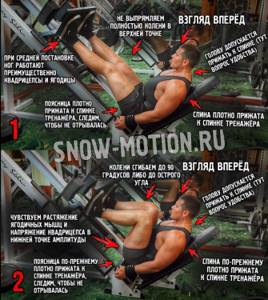
Here is an option with wide legs:
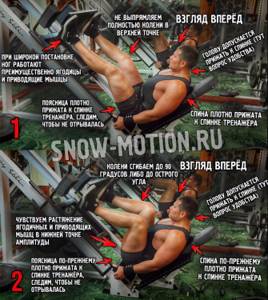
Here is an option for narrow leg stance:
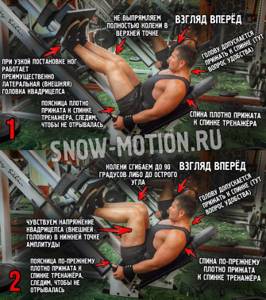
Watch your feet
Ideal bench press technique begins with a starting position: find the appropriate rack height, lock your upper back, plant your feet on the floor, and place your hands and wrists correctly.
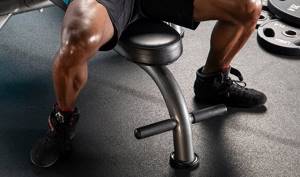
When taking the starting position, many powerlifters completely forget about the position of their feet. Meanwhile, this detail is very important in terms of stability and generating maximum force from the lower body. The width of your feet is a matter of personal preference, but the general rule is that the closer you place your feet, the easier it is to make a mistake and lift your butt off the bench. Once that happens, you can give your bench press a goodbye kiss.
I recommend finding a foot position in which your calves are almost vertical during the bench press. If you use a strong backbend, you can pull your feet back a little and rise on your toes. In this position, you trade maximum force from your legs for maximum bending. If you're an experienced powerlifter who can lift the barbell in this style—and lift it safely—then go for it.
If you can place your feet far back without lifting on your toes, you will create maximum tension in your upper body. This will allow you to get into a stable position so that you can generate the most force from your lower body. If your short height prevents you from getting into this position, you're still in luck: in powerlifting competitions, short athletes are allowed to use a platform or weight plates under their feet. (But don't even think about placing your feet close together in competition. This is a gross violation of any powerlifting federation's rulebook and will result in immediate disqualification.)
Exercise options
The most popular machine is one that allows you to press at an angle of approximately 45 degrees. The exercise can be performed with a fairly large amplitude, using serious weights.
The vertical press allows you to change the vector of movement. The knees will not fall towards the shoulders, as is the case with the angled press, but towards the stomach. This way of performing the exercise helps to focus on working the quadriceps. Especially with narrow feet. It is worth taking safety precautions responsibly, because... even the slightest mistake can lead to serious problems.
A machine that can be used to perform seated leg presses is even rarer. However, its effectiveness is very high. The chair and platform are approximately in the same plane. There is no tilt. The horizontal press allows you to increase the range of motion. But the working weight will be significantly reduced.
Benefits of Exercise
The platform leg press has a ton of benefits. That is why almost everyone, both boys and girls, performs the exercise. In their reviews, they highlight the following main advantages of the exercise:
- By moving your legs, you can load a variety of muscles.
- There is no axial load on the spine. Thanks to this, the exercise can be done even by those who have weak muscles.
- During the exercise, a large number of calories are burned.
- Metabolism increases.
- The functioning of the genital area improves. This is due to blood flow to the pelvic organs.
Using a hack machine
It is more correct to call this exercise hack squats. With the help of the simulator you can achieve maximum results in pumping your legs. The machine allows you to fix your back, which reduces the risk of injury. Unlike regular squats, the technique is simpler. You can train without the help of a partner and safety net. The exercise helps to work the quadriceps and gluteal muscles. The calves are also involved in the training.
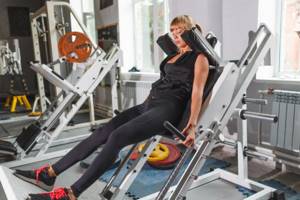
Safety regulations
The technique of performing leg presses in the simulator plays a very important role. It is necessary to clearly understand that even small inaccuracies can lead to serious consequences. Regardless of what kind of exercise you perform, you need to familiarize yourself with the general recommendations.
- Take the starting position. To do this, sit in the simulator, press your back and head tightly against the chair. Place your feet at the required angle. Raise the platform and deploy the safety mechanism. You cannot straighten your legs completely. With your hands, grab the handles that are on the sides.
- Slowly lower the platform. At the same time, you need to take a breath. All weight should be on your heels. It is not recommended to transfer it to the forefoot. Otherwise, you may lose control of movement. Make sure that your knees do not curl inward while lowering the platform.
- Having lowered the platform as low as possible, begin to gently raise it while exhaling. There is no need to lift your lower back while moving. Although it is required to lower the platform as low as possible, feelings of pain and discomfort should not arise. You cannot straighten your legs completely; this is dangerous for your knees.


